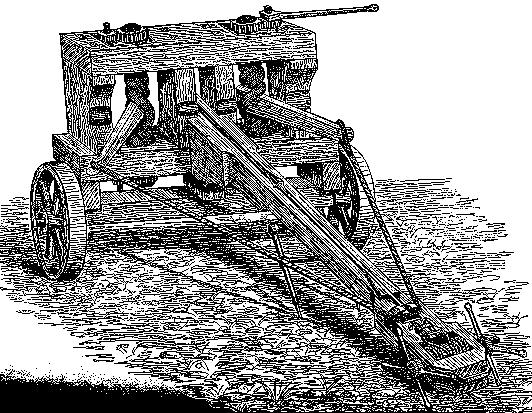Ballista
The ballista was another invention of the Romans, though the first models were small and manufactured mainly for close combat on fields. A popular infantry formation used by the Greeks, Romans, Etruscans and others, was a close-quartered human chain. Several ranks deep, the rows were staggered with shielders, lancers, swordsmen and archers. The ballista fired a spear-sized bolt capable of impaling many men in a row. Again the weapon was employed mainly as an anti-personnel device.
It is believed that the Germans or Italians modified this weapon in the early 13th Century to employ it as a siege engine. Capping the tip of the bolt (spear) with steel or iron, it was extremely effective at punching holes into stone walls and buildings. The design of the ballista was crude and simple. It was a large crossbow mounted on wheels. It had an effective range of approximately 80 - 100 yards.

The ballista was employed as both, an anti-personnel and siege engine up until the late 15th century when its cumbersome design and slow loading made it ineffective against gunpowder weapons.
Battering Rams And Siege Towers
Battering Rams were one of the most simplistic weapons ever employed in battle and their origins date as far back as Babylon. They were long posts, sometimes with mounted handles, other times on wheels, that were rolled or carried repeatedly to bash against city walls and gates. As castle defenses improved, the men assigned to operate these weapons were often subjected to a rain and hail of debris and boiling pitch from the walls and ramparts above. This led to some battering rams being covered by tarps and protective shields to protect their controllers.
Siege Towers were for the most part, ineffective unless used in great numbers. They consisted of scaffolding on wheels that housed troops and archers. They were pushed against castle walls at which makeshift drops and bridges could be released to allow the troops inside to access the ramparts. As these items were large, slow and cumbersome, their approach was often met with flaming arrows, making them a deathtrap for those inside. However, they did prove somewhat effective when used in large numbers. Some were empty and employed as decoys to draw attacks and fire away from the towers that actually housed and supported troops. Casualties were always high when Siege Towers were used.
Catapult
Ballista
Medieval Castle Siege Tactics